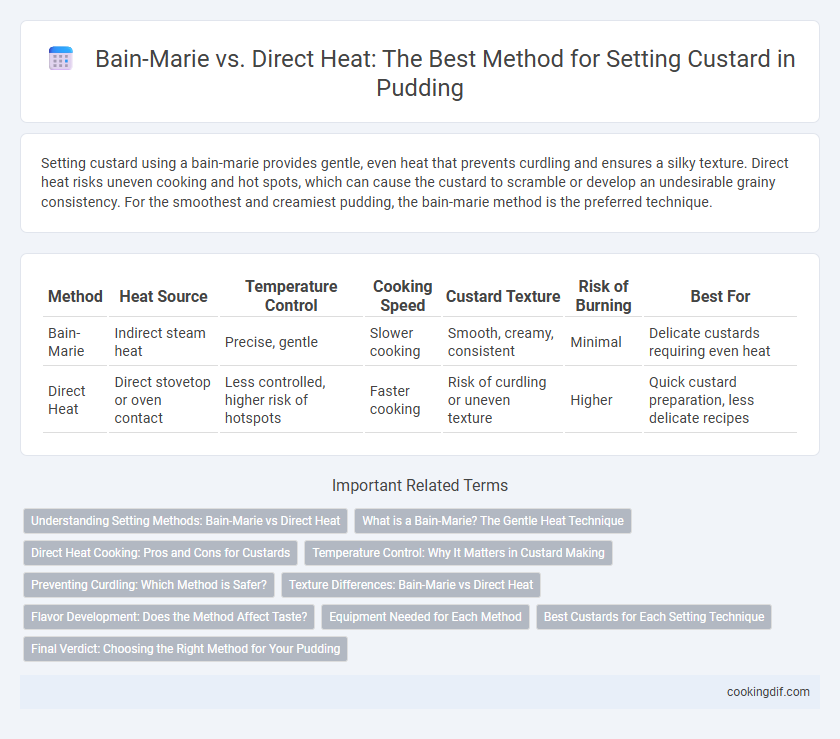Setting custard using a bain-marie provides gentle, even heat that prevents curdling and ensures a silky texture. Direct heat risks uneven cooking and hot spots, which can cause the custard to scramble or develop an undesirable grainy consistency. For the smoothest and creamiest pudding, the bain-marie method is the preferred technique.
Table of Comparison
| Method | Heat Source | Temperature Control | Cooking Speed | Custard Texture | Risk of Burning | Best For |
|---|---|---|---|---|---|---|
| Bain-Marie | Indirect steam heat | Precise, gentle | Slower cooking | Smooth, creamy, consistent | Minimal | Delicate custards requiring even heat |
| Direct Heat | Direct stovetop or oven contact | Less controlled, higher risk of hotspots | Faster cooking | Risk of curdling or uneven texture | Higher | Quick custard preparation, less delicate recipes |
Understanding Setting Methods: Bain-Marie vs Direct Heat
Using a bain-marie ensures gentle, even heat distribution, preventing curdling and achieving a smooth, silky custard texture ideal for delicate puddings. Direct heat applies intense, uneven heat that can cause the custard to cook too quickly, leading to a grainy or lumpy consistency and increased risk of burning. Mastering the bain-marie technique optimizes thermal control, essential for custards requiring slow, precise coagulation for perfect pudding setting.
What is a Bain-Marie? The Gentle Heat Technique
A Bain-marie is a cooking method that uses gentle, indirect heat by placing a heatproof container with custard into a larger pan of simmering water, ensuring even cooking without curdling. This technique prevents the custard from overheating and helps it set smoothly with a creamy texture. Unlike direct heat, the Bain-marie minimizes the risk of burning or scrambling the custard, producing a delicate, stable pudding.
Direct Heat Cooking: Pros and Cons for Custards
Direct heat cooking for custards allows faster setting by applying heat directly to the mixture, making it ideal for quick preparation. However, this method risks uneven cooking and curdling due to the high temperature, which can compromise the smooth texture essential for pudding. Maintaining careful temperature control is critical to avoid overcooking and to achieve a creamy consistency.
Temperature Control: Why It Matters in Custard Making
Precise temperature control is crucial in custard making to prevent curdling and ensure smooth texture. Bain-marie provides gentle, even heat by surrounding the custard with hot water, maintaining a stable temperature below boiling point. Direct heat often risks overheating, causing protein coagulation and grainy custard, whereas bain-marie protects delicate ingredients and fosters creamy results.
Preventing Curdling: Which Method is Safer?
Using a bain-marie to set custard provides a gentler, more controlled heat environment that significantly reduces the risk of curdling by evenly distributing heat around the pudding. Direct heat applies high and uneven temperatures that can cause proteins in the custard to coagulate too quickly, leading to a grainy texture and separation. Therefore, the bain-marie method is safer and preferred for achieving a smooth, creamy custard without curdling.
Texture Differences: Bain-Marie vs Direct Heat
Using a bain-marie for setting custard results in a smoother, creamier texture due to gentle, even heat distribution that prevents curdling. Direct heat often causes uneven cooking, leading to a grainy or rubbery texture as the custard proteins coagulate too quickly. Proper temperature control with a bain-marie ensures a delicate, silky pudding consistency favored in classic dessert preparations.
Flavor Development: Does the Method Affect Taste?
Using a bain-marie for setting custard allows gentle, even heat distribution that prevents curdling and promotes a creamy texture with more nuanced flavor development. Direct heat can cause uneven cooking and risk overcooking, leading to a less smooth custard with potential burnt or bitter notes. The controlled moist heat of the bain-marie enhances custard's delicate sweetness and richness, resulting in a superior taste experience.
Equipment Needed for Each Method
Bain-marie requires a heatproof dish placed inside a larger pan of simmering water, along with an oven or stovetop setup to maintain gentle, even heat. Direct heat custard setting needs only a heavy-bottomed saucepan or double boiler on the stovetop to prevent burning and allow careful temperature control. The bain-marie method typically demands additional equipment like an ovenproof container and a roasting pan, while direct heat relies mainly on precise stovetop temperature management.
Best Custards for Each Setting Technique
Custards set using a bain-marie develop a smooth, creamy texture ideal for delicate desserts like creme brulee and flan, as the gentle steam heat prevents curdling. Direct heat methods suit thicker custards such as pastry cream or stovetop pudding by allowing quicker thickening but require constant stirring to avoid lumps. Choosing the right technique enhances custard quality, balancing temperature control with desired consistency and richness.
Final Verdict: Choosing the Right Method for Your Pudding
Using a bain-marie to set custard ensures gentle, even heat distribution, reducing the risk of curdling and resulting in a smooth, creamy texture. Direct heat, while faster, often leads to uneven cooking and potential burning at the edges, compromising the pudding's consistency. For optimal custard pudding, the bain-marie method remains the preferred choice for achieving a delicate, perfectly set finish.
Bain-marie vs direct heat for setting custard Infographic

 cookingdif.com
cookingdif.com